Life
Simplician was born about 320 probably in Rome and still young he became a churchman. [2] He became expert in the Holy Scripture and very educated. In about 355 he took an active part in the conversion to Christianity of the philosopher Marius Victorinus. When in 374 Ambrose was elected bishop of Milan and baptized, Simplician became his teacher of doctrine. [3] Ambrose used to call Simplician father, as a sign of spiritual relationship. Probably in this period Simplician moved to Milan where he remained.
Simplician took also an active part in the conversions of both Alypius of Thagaste and Augustine of Hippo. The meeting between Augustine and Simplican occurred in Milan in 386 and it is recorded in Augustine's Confessions. [4] After his conversion, Augustine also called Simplician father, and in 397 he dedicated to Simplician two books on the issue of predestination, known as De Diversis Quaestionibus ad Simplicianum.
On his deathbed, Ambrose supported Simplician as his own successor, stating that Simplician was "old but good". Thus in April 397, the aged Simplician was elected bishop of Milan, at that time capital of the Western Roman Empire. The most important act of his episcopate was the receipt in Milan of the relics of the three martyrs Sisinnius, Martyrius and Alexander, sent from Trento by the bishop Vigilius. [2]
Simplician was asked to judge some doctrinal statements by the Council of Carthage (397) and by the First Council of Toledo. He also consecrated Gaudentius of Novara a bishop, and according to the 13th-century writer Goffredo of Bussero, he organized the texts of the Ambrosian liturgy. [2]
Simplician's feast day was anciently set on 15 August, together with the feast of the translation to Milan of the relics of Sisinnius, Martyrius and Alexander; so his death was deemed to have been on 15 August 400; but probably Simplician died between the end of 400 and the first half of 401. [5] Simplician's feast day was later moved to 16 August so as not to conflict with the Assumption of Mary, and with the reform of the Ambrosian Rite that occurred after the Second Vatican Council his feast day was moved to 14 August. [6]
Simplician was initially buried in the church of Saint Nabor and Felix in Milan and later translated, perhaps on 15 August, to the Basilica Virginum ("Basilica of the Virgins") which was renamed in his honor; now it is known as Basilica of St. Simplician. [6] In 1582 St Carlo Borromeo, the cardinal archbishop of Milan, ordered a canonical recognition of Simplicianus' remains who were tumulated under the major altar [7] and then his holy relics were translated during a solemn procession to the odiern temple. [8]
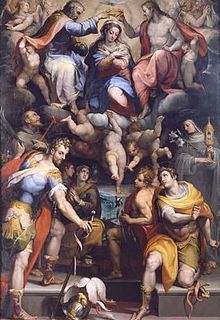
Nabor and Felix were Christian martyrs thought to have been killed during the Great Persecution under the Roman emperor Diocletian. A tomb in Milan is believed to contain their relics.

The Basilica of San Simpliciano is a church in the centre of Milan, Italy northern, the second oldest in the form of a Latin cross, first erected by Saint Ambrose. It is dedicated to Saint Simplician, bishop of Milan.

Benedict was Archbishop of Milan from c. 685 to c. 732. He is honoured as a saint in the Catholic Church.
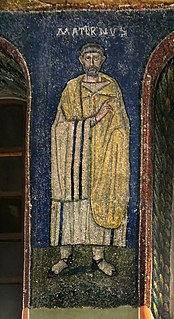
Maternus was Archbishop of Milan from c. 316 to c. 328. He is honoured as a Saint in the Catholic Church and his feast day is on July 18.

Castritian was Bishop of Milan in mid 3rd-century. He is honoured as a Saint in the Catholic Church and his feast day is on December 1.

Monas was Bishop of Milan from the end 3rd-century to early 4th-century. He is honoured as a Saint in the Catholic Church and his feast day is on October 12.

Saint Vigilius of Trent is venerated as the patron saint and bishop of Trent. He should not be confused with the pope of the same name.
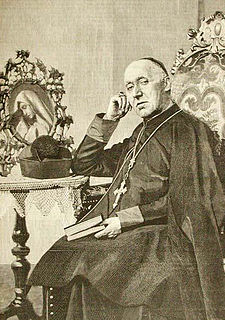
Luigi Nazari di Calabiana was an Italian churchman and politician: a senator of the Kingdom of Sardinia and Archbishop of Milan.
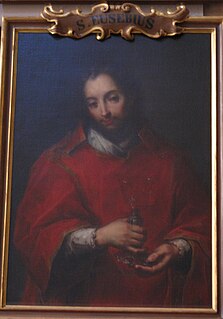
Eusebius was Archbishop of Milan from 449 to 462. He is honoured as a saint and his feast day is 12 August.
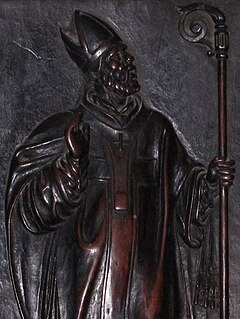
Venerius was Archbishop of Milan from 400 to 408. He is honoured as a Saint in the Catholic Church and his feast day is May 6.

Gerontius was Archbishop of Milan from 462 to 465. He is honoured as a Saint in the Catholic Church and his feast day is 5 May.
Benignus was Archbishop of Milan from 465 to 472. He is honoured as a Saint in the Catholic Church and his feast day is September 20.

Dionysius was bishop of Milan from 349 to 355. He is honoured as a Saint in the Catholic and Eastern Orthodox Churches and his feast day is 25 May.

Caius was Bishop of Milan in early 3rd-century. He is honoured as a Saint in the Catholic Church and his feast day is on September 27.

Anathalon was the first recorded Bishop of Milan and lived at the end 2nd-century or early 3rd-century. He is honoured as a Saint in the Catholic Church and his feast day is on September 25 in Milan. A late tradition made him the first bishop of Brescia where his feast day is celebrated on September 24.
Lawrence I was Archbishop of Milan from 490 to c. 511. He is honoured as a saint in the Catholic Church and his feast day is July 25.

Magnus was Archbishop of Milan from 518 to c. 530. He is honoured as a saint in the Catholic Church.
Natalis was Archbishop of Milan in the mid-8th century. He is honoured as a saint in the Catholic Church and his feast day is May 13.

Mansuetus was Archbishop of Milan from 676 to 685. He is honoured as a saint in the Catholic Church.
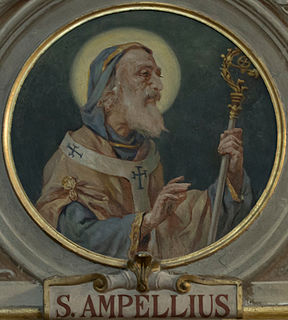
Ampelius was Archbishop of Milan from 671 to 676. He is honoured as a saint in the Catholic Church.
This page is based on this
Wikipedia article Text is available under the
CC BY-SA 4.0 license; additional terms may apply.
Images, videos and audio are available under their respective licenses.

















